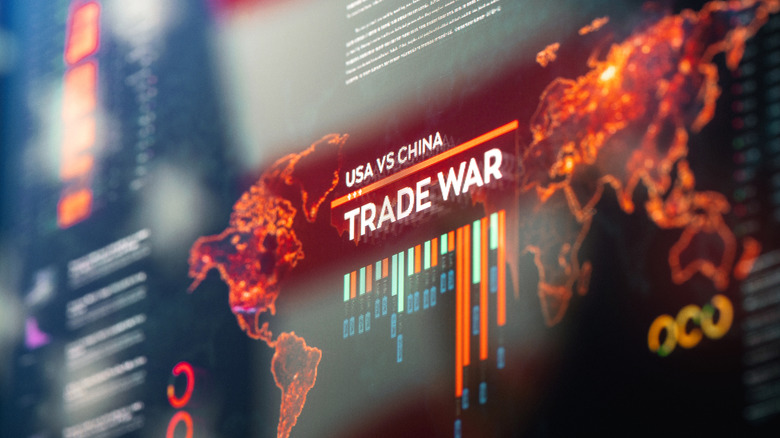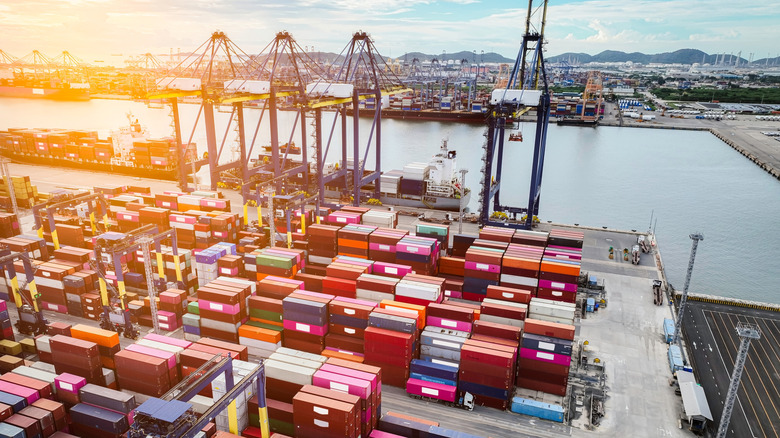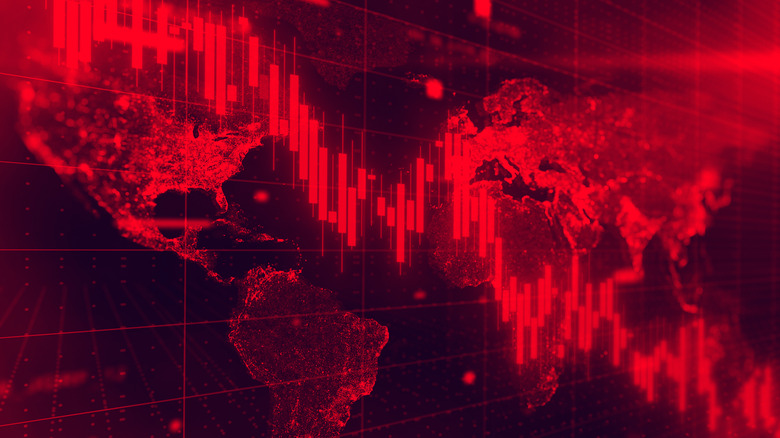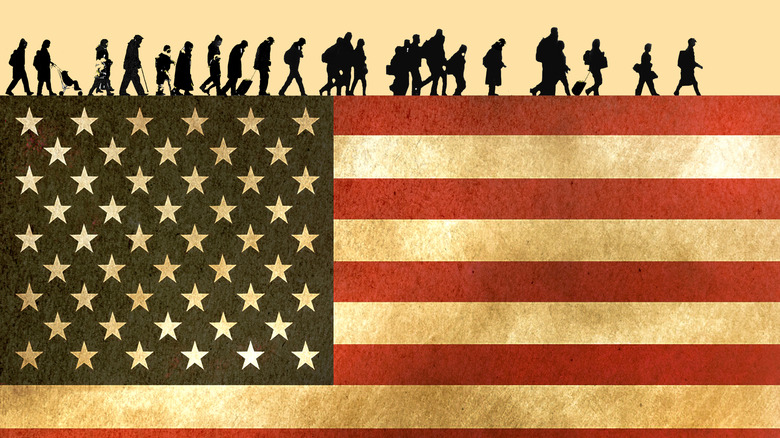Tariff Red Flags We Shouldn't Ignore From The Great Depression
The new administration led by President Donald Trump has been vocal about its desire to impose tariffs on imported goods. Economists from all corners have largely proclaimed this to be a bad or even catastrophic idea. The reality of blanket tariffs is a new normal in which American consumers must pay more for the imported goods they use. A host of crucial items from China (like furniture and electronics) and things like cars, fruits and vegetables, and medical equipment from Mexico will all suddenly become significantly more expensive. But that's not the end of novel trade war hostilities. American exports will ultimately see the same treatment, making demand for U.S. corn, petroleum products, and aircraft components dip sharply.
These are the realities of a tariff-fueled trade war. Fortunately for spectators in the modern age, exploring what form these consequences might take isn't an exercise in hypotheticals. Less than 100 years ago, the U.S. moved toward a protectionist trading stance through the Smoot-Hawley Tariff Act (in 1930), legislation that ultimately helped deepen the pain of the great depression and lengthened its effects. Lessons from this time are both vaguely recent and generally documented, allowing modern Americans to reach back just a few generations and explore how tariffs and other measures designed to limit the influence of global trade can affect the domestic marketplace. Spoiler alert: It's largely negative, but there are some surprising opportunities that present themselves among the wreckage, too.
American exports will contract and prices across the board will soar
First of all, tariff policies enacted right around the beginning of the Great Depression didn't launch this period of economic turmoil. The decline of American finance was already in progress when tariffs were placed on imported goods. However, the imposition certainly prolonged the pain. Global trade was a pronounced element in society a century ago, but it's even more definitive today. With the advent of air travel came a fledgling air cargo industry that has only become exponentially more prominent in the years since. Buying wine from France or Argentina or scooping up jewelry crafted in Thailand is far easier today than even a decade ago.
Tariffs will upend that global norm. Prices for all kinds of goods will shoot up, with grocery stores and gas pumps likely seeing the most damaging price hikes to the American consumer. Particularly, produce across the country (which, regardless of category comes primarily from Mexico) and gas prices in the Midwest (sourced heavily from Canada) will see major jumps. It's hard to estimate the precise toll, but with as much as 25% added to the top on all imports from these trading partners, it will result in at least a commensurate bump. Similarly, to keep pace with new costs to do business in America, export tariffs should be expected in direct retaliation, minimizing the demand for U.S. goods substantially and cutting deeply into the pockets of those in the manufacturing and farming communities. Businesses will lose revenue and workers will lose jobs.
The stock market will almost certainly take a hit
Companies across the U.S. marketplace are bracing for the impact of tariffs on their profit margins. Plenty of American enterprises rely on imported good from all around the world, including Mexico, Canada, and China. This means that their bottom line is vulnerable to widespread negative pressure. Stemming directly from this pressure, publicly traded companies will see a new test to their long-term viability and pricing on the stock market. Weakened earnings largely result in weakened stock market value and hard choices internally. Drawing back to the example seen during the Great Depression, stock market value was already swirling, but it tanked when tariff legislation took effect. The ongoing economic crisis saw the market lose tremendous value, but the worst period of time for American stocks came as a direct result of this new import taxation strategy.
The Tariff Act was signed into law in June of 1930, with the Dow Jones hovering just above 200, two years later, both Reed Smoot and Willis Hawley would shortly lose their seats in Congress as the average slid to just 42 ahead of the midterms that year. Americans today can and should expect to see at least a marked uptick in stock market turmoil, just as they did a century ago when tariff legislation cratered value and left it limping for over a decade to follow.
There's another, more menacing lesson buried in the economics of protectionism
When hard times arrive, people often look to explain their problems through easily digestible frameworks. Exploring the nuanced economic factors that caused a run on the banks (and the complex environmental conditions responsible for The Dust Bowl that exacerbated this trouble), leaving the country in shambles through the 1930s isn't simple or brief. Economic turbulence and many other big picture issues are easier to explain away through snapshots of the social sphere. In Britain and elsewhere on the European continent, "immigration" has become the buzzword to contain all of the economic woes that people are feeling. Similar sentiments can be seen in the United States. While there's no denying an economic impact from increased movement into a country, national policy can be altered to manage crisis situations without placing focus on specific individuals or groups.
A different kind of economic lesson can be taken from these kinds of conditions. Throughout much of contemporary history, economic hardship has helped fuel contrarian politics. The hard shift embracing protectionism is one natural mental descendant of growing financial difficulty. In broad terms, economists largely find themselves opposed to protectionist politics, but the approach continues to pop up all around the world. From Chile through the entirety of the post-war period (until the 1980s) to a full scale British exit from the EU in 2020, the framework remains a popular outlet. Undeniably important, the global financial meltdown in the 1930s was also directly responsible for the politics of isolationism and scapegoating that elected Adolf Hitler in Germany.
Upended norms may lead to uncharted trade negotiating territory
Economic pain isn't the only outcome of insulation or austerity politics. There are actually some alternative routes that may present themselves during trade wars and other periods of stagnant global participation. In fact, depending wholly on the craftiness and wisdom of the administration and its negotiating team, there's perhaps a silver lining to engaging in a trade brawl, and it's precedent comes from the network of agreements forged after depression-era tariffs were implemented. It's one that can reshape global trade in a largely positive way with plenty of auxiliary benefits to the U.S. and its interests.
The concept of "Most-Favored-Nation" status has been around for at least a century. It's commonly referred to today as "permanent normal trade relations" as a means to remove the connotation it brings about. In reality, MFN status just means that all trading partners must be treated equally and is a foundational component of the World Trade Organization. In principle, this means that a tariff on one country's imports must be met with a blanket tariff on all others. But a new trade war could upend the status quote and facilitate a move toward individual bargaining, just like it did in the years after the Smoot-Hawley Act effectively kneecapped the global escape from spiraling economic calamity. A primary rationale for imposing tariffs on Chinese imports, particularly, is a desire to reduce American reliance on Chinese processing power, an economic and national security concern rolled into one. With a new normal taking effect and individual agreements worked out across the globe, federal negotiators might be able to effectively limit products like Chinese microchips while returning other segments of trade with the country and the world to a cooperative and financially viable equilibrium.




